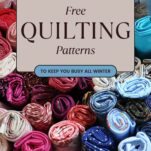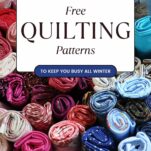This post contains affiliate links. I could be an affiliate for many different products, but I chose these specifically because they are the products and brands I like and recommend. By using my links, you help support this website.
Winter is the perfect time to cozy up indoors with a quilting project.
Winter inspires us with the intricate patterns of snowflakes and the quiet beauty of barren trees against a snowy backdrop; the winter season is a quilter’s muse.
In this post, we curated a collection of quilting patterns perfect for winter, offering warmth, beauty, and a nod toward Valentine’s and St. Patrick’s Day.
January quilting projects
1. Winter Seeds Table Topper

The “Winter Seeds Table Topper” is a charming project featured in the June edition of the Christmas Once a Month series on The Crafty Quilter blog.
This project is perfect for adding a festive touch to your winter table.
The quilt features the melon (or pumpkin seed) block; the table topper incorporates simple applique and angles to create a design that looks more complicated than it is. My favorite kind of quilt!
Crafted with fabric from the Winter’s Lane Collection by Kate and Birdie Paper Co for Moda, the finished table topper measures 27 1/2″ wide.
Winter Seeds Table Topper from The Crafty Quilter
2. Monthly Mini Quilts for January

The “Friendship Mini” quilt is the inaugural project in the Monthly Mini Quilts series from SewCanShe.
The series is designed to be an accessible entry point for beginners to the quilting world.
Centered around the classic Friendship Star, this mini quilt measures approximately 8″ square and is composed entirely of 16 half-square triangles and 9 squares.
Using mini-charm packs, specifically two Flower Sugar Paisley Wind packs from Lecien for a mix of colors, this project teaches fundamental quilting techniques and offers a beautiful way to use those precious pre-cut fabric squares.
Perfect for those looking to dip their toes into quilting or for experienced quilters in search of a quick and satisfying project.
Monthly Mini Quilts for January from Sew Can She
3. The Make-it-Over-the-Weekend Flannel Quilt Instructions
The “Make-It-Over-The-Weekend Flannel Quilt” project from Simple Simon and Co. is a cozy crafting project, perfect for quilters of all levels.
This quilt design is simple and quick to assemble. You can select your fabric and complete the quilt in just a weekend.
The quilt is constructed from a series of solid squares alternated with four-patch blocks, creating a charming and warm oversized lap quilt.
It works well with both flannel and quilting cotton and can be easily adjusted in size by adding more blocks.
Weekend Flannel Quilt from Simple Simon & Company
February quilting projects
4. Quilted Heart Tutorial

The Quilted Heart Tutorial from The Crafty Quilter is a project perfect for adding a touch of charm to your home decor or as a thoughtful handmade gift.
These quilted hearts can be blinged out with buttons, ribbons, and baubles.
The heart template provided in the tutorial is adjustable, so you can make different hearts.
This project is ideal for quilters looking for a quick project to celebrate February – or as a gift for anyone you love.
I like Crafty Quilter’s idea of creating a heart tree. We used to have one of these in our foyer for every holiday. That’s a tradition I need to bring back.
Quilted Heart Tutorial from The Crafty Quilter
5. Chains of Love

The “Chains of Love” quilt project by Jedi Craft Girl is perfect for Valentine’s Day or to add a touch of love to any room.
It uses 5 fat quarters and cleverly combines the Irish Chain style with pieced hearts at the center, resulting in a 50″ square quilt that’s as much eye candy as it is a snuggler.
The project is designed to push the limits of a fabric colorway, making it an excellent challenge for quilters looking to create the most out of a limited palette of red and pink.
This quilt is a fun weekend project and a beautiful way to celebrate February.
Chains of Love from Jedi Craft Girl
6. Scrappy Rag Quilt Tutorial

The “Its Fall-Y’All Scrappy Rag Quilt Tutorial” on A Vision to Remember is suggested for fall; a flannel rag quilt could not be more “winter.”
This modified log cabin quilt is scrappy, using 2.5-inch pieces of various lengths sewn into a square, reminiscent of the traditional log cabin pattern.
The tutorial guides you through creating two large blocks, each measuring about 44 inches square, and then cutting and piecing them uniquely to achieve the rag quilt effect.
This tutorial is perfect for quilters looking for a winter-themed project or any quilter wanting to try their hand at a rag quilt with a twist. The quilt’s design is adaptable, allowing various sizes and fabric choices to match any decor or season.
Scrappy Rag Quilt Tutorial from A Vision to Remember
March quilting projects
7. Shamrock Table Runner for St. Patrick’s Day
“Shamrock Table Runner Part 1” by “Our Time To Quilt!” is a tutorial for making a charming Shamrock Table Runner, perfect for March.
Deb Johnson guides you through creating this table runner, emphasizing the use of scraps for a fun and economical project.
The tutorial is designed to be easy and quick, making it suitable for quilters of all levels. Deb also shares tips on quilting and fabric preparation, such as starching fabric for better accuracy in cutting and piecing.
This is a 2-part tutorial, so check out her channel.
Shamrock Table Runner from Our Time to Quilt
8. Interlock Pattern

The “Interlocked” quilt pattern, designed by Elise Lea for Robert Kaufman Fabric Company, is a visually striking quilt that features an intricate interlocking design.
This pattern is available for free on the Robert Kaufman website.
This pattern appeals to quilters looking for a modern and dynamic project.
Interlock Pattern from Robert Kaufman
9. Lucky St. Patrick’s Day Pillow Tutorial

The “LUCKY St. Patrick’s Day Pillow Tutorial” on Jedi Craft Girl’s blog is a creative and festive project perfect for adding a touch of Irish charm to your home decor.
The pillow is perfect for digging into your green fabric scraps.
The tutorial is ideal for quilters and crafters looking for a quick and enjoyable project to celebrate St. Patrick’s Day.
Lucky St. Patrick’s Day Pillow Tutorial from Jedi Craft Girl
Tips and tools for quilting
What you need to get started quilting
- Rotary Cutter: A rotary cutter allows for precise cuts through multiple layers of fabric at once. It’s essential for quickly cutting strips, squares, and other shapes. A 45mm blade is a versatile size for various projects.
- Cutting Mat: A self-healing cutting mat protects your surfaces and helps extend the life of your rotary cutter blade.
- Acrylic Rulers: Acrylic rulers are used with your rotary cutter and mat to make precise cuts. A good starter set includes a 6″x24″ ruler for cutting yardage and a 12.5″ square ruler for squaring up blocks.
- Fabric Scissors: A sharp pair of fabric scissors is indispensable for snipping threads and trimming fabric. Reserve them exclusively for fabric to keep them sharp. How many of us grew up knowing that we NEVER touch mom’s orange sewing scissors?!
- Seam Ripper: We all have to reverse sew sometimes, and a seam ripper is a quilter’s best friend for undoing stitches quickly and cleanly.
- Sewing Machine: A basic sewing machine that can do straight stitches is sufficient for starting quilting.
- Quilting Needles: Use quilting or sharp needles for hand sewing and machine quilting. They are stronger than universal needles and are designed to go through multiple layers of fabric and batting.
- Cotton Quilting Thread: 100% cotton thread is strong and durable, making it ideal for piecing and quilting.
- Pins and Pin Cushion: Fine, sharp pins are useful for securing fabric pieces together before sewing. A magnetic pin cushion or a traditional stuffed one keeps pins organized and within reach.
- Iron and Ironing Board: Pressing seams is crucial for accurate piecing and a professional-looking finish. A good steam iron and a sturdy ironing board are must-haves.
- Quilting Gloves: While not strictly necessary, many quilters find that gloves with rubberized fingertips help grip the fabric better during machine quilting, providing smoother movement under the needle.
- Safety Pins or Basting Spray: You can use safety pins or a basting spray for basting the quilt layers together before quilting. Both methods have their fans; choose what works best for you.
Tips for a successful quilting project
Tip 1: Start Simple
Begin with a straightforward project, such as a patchwork quilt or a table runner, to build your confidence and skills before tackling more complex designs.
Tip 2: Choose the Right Fabric
Select quilting cotton. It’s designed for quilting, so it’s durable and easy to work with. Pre-wash your fabrics to prevent shrinkage and color bleeding.
Tip 3: Accurate Cutting is Key
Take your time to cut your pieces accurately. This will ensure that your quilt blocks fit together perfectly and your finished quilt looks professional.
Tip 4: Consistent Seam Allowances
Use a consistent seam allowance (usually 1/4 inch for quilting). A quarter-inch presser foot for your sewing machine is a sanity saver.
Tip 5: Press, Don’t Iron
Press your seams to one side or open, depending on your pattern’s instructions, to prevent distortion. Avoid moving the iron back and forth over the fabric, which can stretch it out of shape.
Tip 6: Measure and Square Up
Regularly measure and square up your blocks during the assembly process to ensure they are the correct size and shape. This makes piecing the quilt top easier.
Tip 7: Baste Carefully
Take your time with basting to prevent wrinkles and puckers. Whether you choose to pin baste, thread baste, or use basting spray, a well-basted quilt is easier to quilt.
Tip 8: Practice Quilting
Before quilting your project, practice on a sandwich made from scraps of fabric and batting. This helps you get comfortable with the process and adjust tension if needed.
Tip 9: Choose a Simple Quilting Design
For your first few projects, choose a simple quilting design, such as straight-line quilting or stitching in the ditch, to gain confidence.
Tip 10: Be Patient and Enjoy the Process
Quilting is a labor of love that requires patience. Take breaks when needed, and remember to enjoy the creative process.
Tip 11: Join a Quilting Group or Class
Learning from others can be incredibly helpful. Consider joining a local quilting group or taking a class to gain insights and tips from more experienced quilters.
Tip 12: Don’t Be Afraid to Rip It Out
If you make a mistake, don’t be afraid to use your seam ripper. Fixing errors as you go can save time in the long run and improve the quality of your finished quilt.
Tip 13: Keep Your Tools in Good Condition
Regularly change your rotary cutter blades and sewing machine needles. Dull tools can lead to inaccurate cuts and poor stitch quality, snagging the threads, or skipping.
Tip 14: Document Your Projects
Keep a journal of your quilting projects, including fabric swatches and notes. This can be a valuable resource for future projects and a lovely record of your quilting journey.
Tip 15: Embrace Imperfections
Every quilter makes mistakes, and no quilt is perfect. Embrace the imperfections as part of the charm and character of your handmade quilt.





